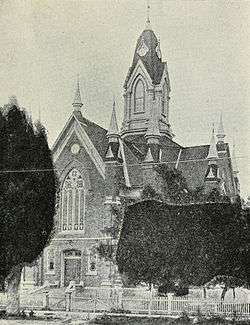Summit Stake Tabernacle
|
Summit Stake Tabernacle | |
|
Formerly listed on the U.S. National Register of Historic Places | |
 Photo published in 1914. | |
 | |
| Location |
Stood at 1st North and Main Sts. Coalville, Utah |
|---|---|
| Coordinates | 40°55′2″N 111°23′56″W / 40.91722°N 111.39889°WCoordinates: 40°55′2″N 111°23′56″W / 40.91722°N 111.39889°W |
| Built | 1899 |
| Architect | Thomas L. Allen |
| Architectural style | Gothic |
| NRHP Reference # | 71001078 |
| Significant dates | |
| Added to NRHP | 1971[1] |
| Removed from NRHP | April 9, 1971 |
The Summit Stake Tabernacle or "Coalville Tabernacle" was a meetinghouse of The Church of Jesus Christ of Latter-day Saints (LDS Church) located in Coalville, Summit County, Utah.
Construction
Plans for the Summit Stake Tabernacle were made shortly after the creation of the Summit Stake in 1877, and the architect and builder was Thomas L. Allen. The cornerstone was laid by Franklin D. Richards on August 7, 1879. The construction of the tabernacle included 600,000 locally-made bricks, 75,000 feet of lumber (both Oregon red pine and local lumber from Echo Canyon), and sandstone from the Coalville ledge quarry. The unique gothic-style architecture included a 117-foot tower that was visible miles away. The interior had stain-glass windows imported from Belgium and an elaborately-painted ceiling. The tabernacle was dedicated on May 14, 1899 by LDS Church President Lorenzo Snow.[2]
Renovation
In the 1940s, renovations took place to alter the interior of the tabernacle into a more functional meetinghouse with classrooms. However, in a short time, even these alterations were deemed inadequate and a new stake center was planned.
Demolition
After serving the Summit Stake and greater Coalville community for over 70 years, church administrators went through with plans to demolish the tabernacle. The building was listed on the Utah State Register of Historic Sites in 1970 and the National Register of Historic Places in 1971 shortly before demolition as attempts to preserve the building.[3] There were other attempts to preserve the building, including a group of residents that tried to place a restraining order on the church, which garnered much media attention, including reports from the New York Times.[4] However, two days after a judge struck down the restraining order, and amidst much controversy, church leaders removed some historically significant items from the tabernacle before bulldozers arrived. On March 5, 1971, the building was razed.
Notes
- ↑ "National Register of Historic Places". NPS Focus. National Park Service. Retrieved 2010-04-12.
- ↑ http://dp.la/item/b7e0141d062871d286a32f02e8d069e2?back_uri=http%3A%2F%2Fdp.la%2Fsearch%3Fpage_size%3D100%26subject%255B%255D%3DMormon%2BChurch--Buildings
- ↑ (PDF) https://www.dialoguejournal.com/wp.../Dialogue_V05N04_44.pdf. Retrieved March 2, 2012. Missing or empty
|title=(help) - ↑ http://www.sltrib.com (2009-07-17). "Utah Local News - Salt Lake City News, Sports, Archive - The Salt Lake Tribune". Sltrib.com. Retrieved 2012-08-15.
Further reading
- Anonymous (Winter 1970), "The Coalville Tabernacle: A Point of View", Dialogue: A Journal of Mormon Thought, 5 (4): 50–58, retrieved 2014-02-26.
- Geary, Edward A. (Winter 1970), "The Last Days of the Coalville Tabernacle", Dialogue: A Journal of Mormon Thought, 5 (4): 42–50, retrieved 2014-02-26.
- Haggerty, John W. (1980). Historic Preservation in Utah, 1960-1980 (Thesis). Brigham Young University. Retrieved 2014-02-26..
- Leone, Mark P. (Summer 1973), "Why the Coalville Tabernacle had to be Razed", Dialogue: A Journal of Mormon Thought, 8 (2): 30–39, retrieved 2014-02-26.
- Salisbury, Paul G. (Winter 1970), "The Lesson of Coalville", Dialogue: A Journal of Mormon Thought, 5 (4): 58–65, retrieved 2014-02-26.
- Smith, Bernett Blonquist (1967), History of Summit Stake Tabernacle, OCLC 122653633.
- Wood, Thomas; Hill, Douglas (Summer 1967), "The Coalville Tabernacle: A Photographic Essay", Dialogue: A Journal of Mormon Thought, 2 (2): 63–74, retrieved 2014-02-26.